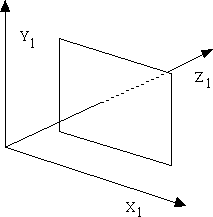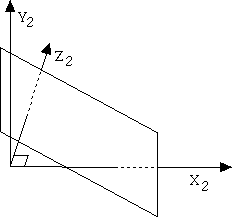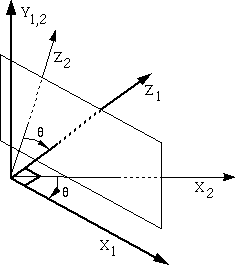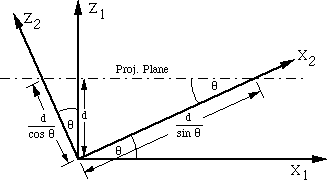
Recall the matrix for one point perspective:
_ _
| 1 0 0 0 |
P = | 0 1 0 0 |
eye | 0 0 1 1/d |
|_ 0 0 0 0 _|

Suppose we wish to view the object such that two principal axises pierce the projection plane. This two-point projection looks as follows. Note that the Z2 and X2 axises pierce the projection plane, but the Y2 axis does not.

(Note on axis terminology: The number that appears after the the axis name tells us which point system we are refering to. That is, the X2 axis is the X-axis in two-point perspective coordinates. Similarily, Y1 refers to the Y-axis in one-point perspective, and Z3 will refer to the Z-axis in three-point perspective.)
So, we need to rotate the points through an angle negative Theta (or the axes through an angle positive Theta). In the picture below, Theta is defined positive according to the X->Y->Z->X convention. Theta is positive if it points from Z2 towards X2.

(q replaces Theta because that is the letter which maps to Theta in the symbol font) where:
_ _
| cos(q) 0 +sin(q) 0 |
R (-q) = | 0 1 0 0 |
y | -sin(q) 0 cos(q) 0 |
|_ 0 0 0 1 _|
_ _
| cos(q) 0 +sin(q) 0 |
R (-q) = | 0 1 0 0 |
y | -sin(q) 0 cos(q) 0 |
|_ 0 0 0 1 _|
When we make these substitutions:
_ _ _ _ _ _ | cos(q) 0 sin(q) 0 || 1 0 0 0 || cos(q) 0 -sin(q) 0 | | 0 1 0 0 || 0 1 0 0 || 0 1 0 1 | | -sin(q) 0 cos(q) 0 || 0 0 1 1/d || sin(q) 0 cos(q) 0 | |_ 0 0 0 1 _||_ 0 0 0 0 _||_ 0 0 0 1 _|
_ _ _ _ | cos(q) 0 sin(q) sin(q)/d || cos(q) 0 -sin(q) 0 | | 0 1 0 0 || 0 1 0 1 | | -sin(q) 0 cos(q) cos(q)/d || sin(q) 0 cos(q) 0 | |_ 0 0 0 0 _||_ 0 0 0 1 _|
_ _
| 1 0 0 sin(q)/d |
P = | 0 1 0 0 |
2 | 0 0 1 cos(q)/d |
|_ 0 0 0 0 _|
So, a point at infinity on the X2 axis is represented as:
[ 1 0 0 0 ]
[ 1 0 0 sin(q)/d ]
[ d/sin(q) 0 0 ]
Similarily, the vanishing point for Z2 lies at:
[ 0 0 d/cos(q) ]
[ 0 1 0 0 ]
Note that when Theta equals zero, P2 reduces to P1.

Theta is the angle between X2 and X1. Because of the projection plane is parallel to X1, the angle between the plane and X2 is also Theta. Since the sine of an angle is equal to opposite/hypotenuse (sin(theta)=opp/hyp), the length of the hypotenuse = opp/sin(Theta). opp=d, so hyp=d/sin(Theta), where hyp points along the X2 axis. This is the same as we derived for the X2 vanishing point using the matricies.
Similarily, Z2 is rotated 90 degrees from X2 and Z1 is rotated 90 degrees from X1. So, the angle between X1 and X2 is the same as the one between Z1 and Z2. cos(theta)=adjacent/hypotenuse, so hyp=adj/cos(Theta). adj=d, so hyp=d/cos(theta), and it points along Z2. This is what we derived for the Z2 vanishing point using matricies.
Now, we would also like a transformation matrix for three-point perspective. Three-point perspective occurs when three principal axes pierce the projection plane. In the following picture, X3, Y3, and Z3 all pierce the project plane.

Like the two-point matrix P2, P3 can be obtained by transforming from a three-point perspective system into a one-point perpective system.
Note: We rotate the axes by -Phi because we are using the X->Y->Z->X rotation convention. That is, since we are rotating from Z3 towards Y3, we are rotating by a negative angle.
Because we are going to be rotating the points instead of the coordinates, we will rotate the points in the opposite direction (why?). So, when we rotate the axes by -Phi, we rotate the points by +Phi.
The point transformation matrix that we need is:
So substitution Rx into the equation for P3:
_ _
| 1 0 0 0 |
R (j) = | 0 cos(j) sin(j) 0 |
x | 0 -sin(j) cos(j) 0 |
|_ 0 0 0 1 _|
_ _ _ _n As we did in two-point projection, we will illustrate what happens to the vanishing points by applying P3 to points at infinity on the X3, Y3, and Z3 axes. As before, in homogeneous coordingates, a point at infinity is represented by placing a zero in the W coordinate of a point vector.So, a points at infinity on the X3, Y3, and Z3 axes:
become (in homogeneous coordinates): z: [ 0 0 1 0 ]eck. x: [ 1 0 0 sin(q)/d ]
_ _
| 1 0 0 sin(q)/d |
P = | 0 1 0 cos(q)sin(j)/d |
3 | 0 0 1 cos(q)cos(j)/d |
|_ 0 0 0 0 _|
x: [ d/sin(q) 0 0 ]
y: [ 0 d/cos(q)sin(j) 0 ]
z: [ 0 0 d/cos(q)cos(j) ]
Thus, if the projection planes intersects the X-, Y-, and Z- axes at (repectively):
[ dx 0 0 ], [ 0 dy 0 ], [ 0 0 dz ]Then the matrix for this 3-point perspective is:
_ _
| 1 0 0 1/dx |
P = | 0 1 0 1/dy |
3 | 0 0 1 1/dz |
|_ 0 0 0 0 _|
dx = dx, dy = dy, and dz = dz.
And, the 1 point and 2 point perspective matrices are special cases with 1/dx and/or 1/dy equal to zero.